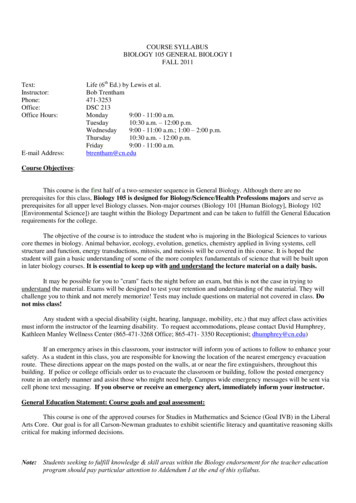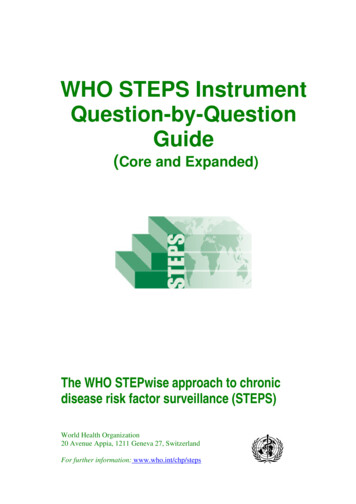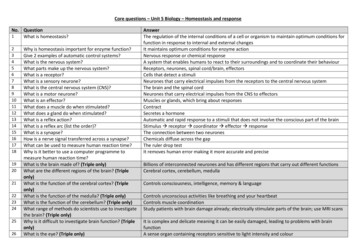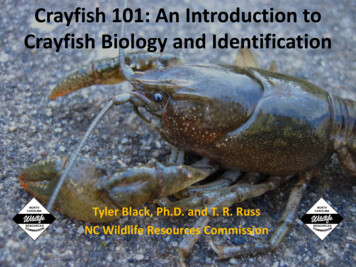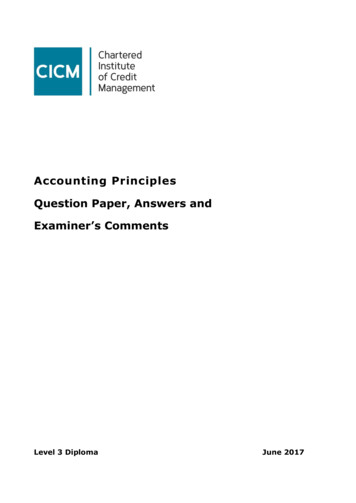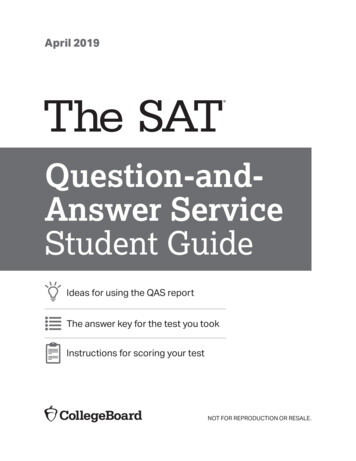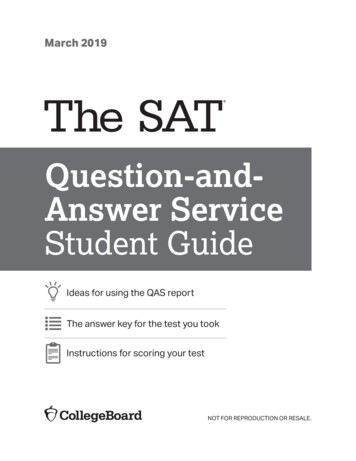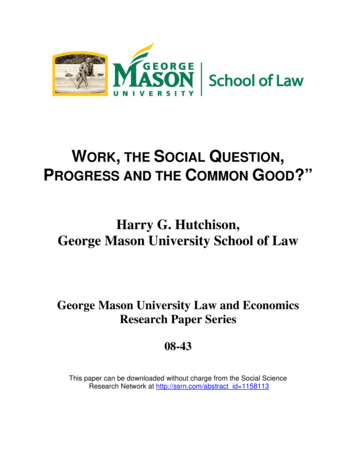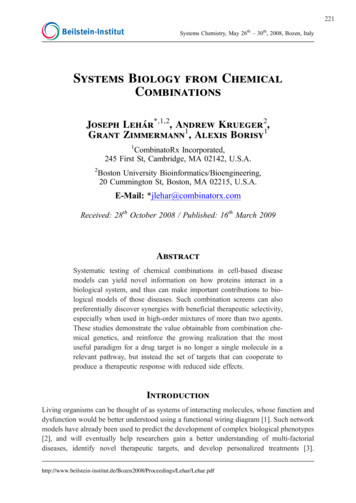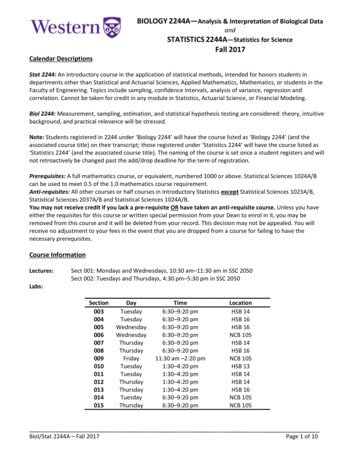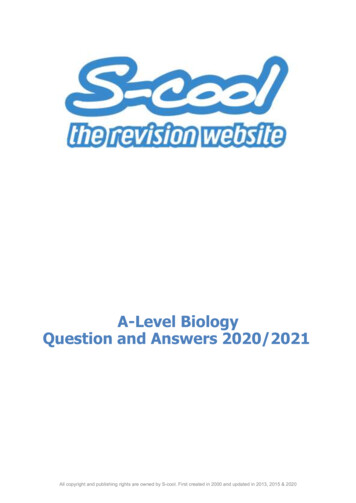
Transcription
A-Level BiologyQuestion and Answers 2020/2021All copyright and publishing rights are owned by S-cool. First created in 2000 and updated in 2013, 2015 & 2020
Table of ContentsTopics that only contain interactive questions . 3Biological Molecules and Enzymes (Questions) . 4Biological Molecules and Enzymes (Answers) . 6Cells and Organelles (Questions) . 8Cells and Organelles (Answers) . 10Classification (Questions) . 13Classification (Answers) . 14DNA and the Genetic Code (Questions) . 16DNA and the Genetic Code (Answers) . 18Ecological Concepts (Questions) . 21Ecological Concepts (Answers). 24Evolution (Questions) . 26Evolution (Answers) . 28Gas Exchange (Questions) * . 32Gas Exchange (Answers) . 35Genetic Engineering (Questions) . 37Genetic Engineering (Answers) . 38Homeostasis (Questions) * . 40Homeostasis (Answers) . 42Immunity (Questions) . 44Immunity (Answers) . 45Movement and Support in Animals (Questions). 47Movement and Support in Animals (Answers) . 49Nervous and Hormonal Control (Questions) . 51Nervous and Hormonal Control (Answers) . 53Nutrition and Digestion (Questions) * . 55Nutrition and Digestion (Answers) . 57Photosynthesis (Questions) . 59Photosynthesis (Answers) . 61Reproduction (Questions) * . 63Respiration (Questions) * . 69Respiration (Answers) . 71Transport (Questions) . 73Transport (Answers) . 77* topics that contain interactive resources, multiple choice questions or audio files. To interact with this content, please goto www.s-cool.co.uk/biology.These questions cover the main areas of this subject. Please check the specific areas you need with your exam board. They areprovided “as is” and S-cool do not guaranteed the suitability, accuracy or completeness of this content and S-cool will not beliable for any losses you may incur as a result of your use or non-use of this content. By using these notes, you are acceptingthe standard terms and conditions of S-cool, as stated in the s-cool website (www.s-cool.co.uk).All copyright and publishing rights are owned by S-cool. First created in 2000 and updated in 2013, 2015 & 2020
Topics that only contain interactive questionsThese topics only contain interactive questions such as animations, multiple choice or audio files. Tointeract with this content, please go to www.s-cool.co.uk/biology. Applications of Genetic EngineeringGeneticsHealth & DiseaseMaking use of the genetic codeAll copyright and publishing rights are owned by S-cool. First created in 2000 and updated in 2013, 2015 & 2020
Biological Molecules and Enzymes (Questions)1. a) The diagram shows the formula of a molecule of an organic compound.(i) To which group of organic compounds does this molecule belong?(1 mark)(ii) Give one way in which this molecule differs from other compounds in the group.(1 mark)b) The table shows some of the organic compounds found in a bacterial cell.Compound Percentage of total dry mass Number of different types of cogen 2.51(i) Glycogen and protein are both polymers. Explain why there can only be one type of glycogen molecule, butthere can be many types of protein.(2 mark)(ii) Explain why there are many types of RNA found in this cell.(2 mark)(Marks available: 6)All copyright and publishing rights are owned by S-cool. First created in 2000 and updated in 2013, 2015 & 2020
2. Succinate is converted to fumarate by the enzyme dehydrogenase. This reaction can be inhibited by addingmalonate.a) Use this information to explain how malonate acts as an inhibitor.(2 marks)b) In an investigation succinate dehydrogenase is mixed with a solution containing both succinate and malonate.What will happen to the rate of fumerate production when the concentration of succinate is increased?(2 marks)(Marks available: 4)3. (a) Give two functions of proteins in cell surface membranes.(2 marks)b) The composition of the inner and outer membranes of a mitochondrion is shown in the table.Phospholipid % Protein %Outer Membrane 4555Inner Membrane 2575Suggest an explanation for the difference in the percentage of protein present in the two mitochondrialmembranes.(2 marks)(Marks available: 4)All copyright and publishing rights are owned by S-cool. First created in 2000 and updated in 2013, 2015 & 2020
Biological Molecules and Enzymes (Answers)Answer outline and marking scheme for question: 1Give yourself marks for mentioning any of the points below:a) (i) Amino acid.(ii) Possession of CH3 group/different R group.(2 marks)b) (i) Glycogen consists of glucose/one type of monomer.Many different amino acids combine to form proteins.(ii) Include messenger and transfer RNA.Each gene gives/each protein will be derived from a different messenger RNA.Each amino acid has a different transfer RNA.(Max 4 marks)(Marks available: 6 marks)Answer outline and marking scheme for question: 2Give yourself marks for mentioning any of the points below:a) Similar (chemical) structure and shape.Competes for active site.(2 marks)b) Increased rate of fumarate production.Less competition at active site.(2 marks)(Marks available: 4 marks)Answer outline and marking scheme for question: 3All copyright and publishing rights are owned by S-cool. First created in 2000 and updated in 2013, 2015 & 2020
Give yourself marks for mentioning any of the points below:a) Carrier molecule; enzyme.Receptor site for hormones/antibodies.Transport gate/channel protein.Antibody.(max 2 marks)b) More protein, more enzyme/channel protein.Used in oxidative phosphorylation/production of ATP/electron transport chain.(2 marks)(Marks available: 4)All copyright and publishing rights are owned by S-cool. First created in 2000 and updated in 2013, 2015 & 2020
Cells and Organelles (Questions)1. Cell organelles can be separated by centrifuging a cell extract in a sucrose density gradient. The organellessettle at the level in the sucrose solution which has the same density as their own.Some animal cells were broken open and the cell extract centrifuged in a sucrose density gradient.Three distinct fractions were obtained, A, B and C, as shown in the diagram: Some animal cells were brokenopen and the cell extract centrifuged in a sucrose density gradient.Three distinct fractions were obtained, A, B and C, as shown in the diagram:One fraction contained nuclei, one contained ribosomes and a third contained mitochondria.a) Identify the organelles (i), (iii) and (v) in each fraction and describe one function of each (ii), (iv) and (vi).Fraction Organelle FunctionA(i)(ii)B(iii)(iv)C(v)(vi)(Marks available: 4)All copyright and publishing rights are owned by S-cool. First created in 2000 and updated in 2013, 2015 & 2020
2. The diagram shows an epithelial cell from the small intestine of a mammal, as seen with an electronmicroscope.a)(i) Suggest one way in which the functions of the rough and smooth endoplasmic reticulum differ.(ii) Give the evidence from the diagram which supports your answer.b) Explain how two features visible in the diagram are adaptations for the absorption of products of digestion(Marks available: 4)3. Write an essay on how the ultrastructure of different cells is related to their functions.(Marks available: 25)All copyright and publishing rights are owned by S-cool. First created in 2000 and updated in 2013, 2015 & 2020
Cells and Organelles (Answers)Answer outline and marking scheme for question: 1a) Give yourself marks for mentioning any of the points below:(i) Ribosomes(ii) Making proteins/assembling amino acid chain/protein synthesis(iii) Mitochondria(iv) Respiration/ formation of ATP/ Krebs cycle/ Oxidative phosphorylation.(v) Nuceli(vi) DNA/RNA synthesis/ controls protein production/ cell activity/ carries genetic information.(Marks available: 4)(1 mark for knowing names of all organelles, and 1 mark for each function explained).Answer outline and marking scheme for question: 2Give yourself marks for mentioning any of the points below:a) (i) Rough ER associated with protein production/ smoother associated with transport.(ii) Ribosomes present/absent.(2 marks)b) Microvilli increase surface area;Mitochondria involved with active uptake.(2 marks)(Marks available: 4)Answer outline and marking scheme for question: 3All copyright and publishing rights are owned by S-cool. First created in 2000 and updated in 2013, 2015 & 2020
You can give yourself up to 2 marks for discussing any of the following issues, up to a maximum of16:General principlesDescribe the structur
You can give yourself up to 2 marks for discussing any of the following issues, up to a maximum of 16: General principles Describe the structure of a eukaryotic cell;
